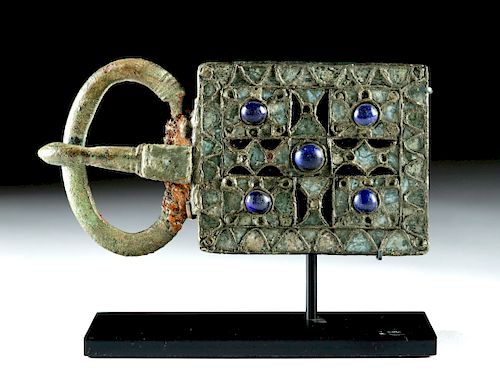Important 5th C. Visigoth Bronze & Glass Buckle
Lot 102
About Seller
Artemis Fine Arts
686 S Taylor Ave, Ste 106
Louisville, CO 80027
United States
Selling antiquities, ancient and ethnographic art online since 1993, Artemis Gallery specializes in Classical Antiquities (Egyptian, Greek, Roman, Near Eastern), Asian, Pre-Columbian, African / Tribal / Oceanographic art. Our extensive inventory includes pottery, stone, metal, wood, glass and textil...Read more
Categories
Estimate:
$7,000 - $10,500
Absentee vs Live bid
Two ways to bid:
- Leave a max absentee bid and the platform will bid on your behalf up to your maximum bid during the live auction.
- Bid live during the auction and your bids will be submitted real-time to the auctioneer.
Bid Increments
| Price | Bid Increment |
|---|---|
| $0 | $25 |
| $300 | $50 |
| $1,000 | $100 |
| $2,000 | $250 |
| $5,000 | $500 |
| $10,000 | $1,000 |
| $20,000 | $2,500 |
| $50,000 | $5,000 |
| $100,000 | $10,000 |
| $200,000 | $20,000 |
About Auction
By Artemis Fine Arts
Jan 16, 2020
Set Reminder
2020-01-16 10:00:00
2020-01-16 10:00:00
America/New_York
Bidsquare
Bidsquare : Ancient | Asian | Ethnographic
https://www.bidsquare.com/auctions/artemis-gallery/ancient-asian-ethnographic-4799
Featuring classical antiquities, ancient and ethnographic art from cultures encompassing the globe. Artemis Fine Arts info@artemisgallery.com
Featuring classical antiquities, ancient and ethnographic art from cultures encompassing the globe. Artemis Fine Arts info@artemisgallery.com
- Lot Description
Southwestern Europe / Iberian Peninsula, Spain or Portugal, Visigoths, ca. 550 to 600 CE. A striking, large bronze belt buckle, its surface decorated with over a dozen inlaid deep blue glass baubles - some hemispherical, some flat and crescent-shaped - and smaller clear glass inlays surrounding them, filling in the entire surface of the belt using the cloisonne technique. The rectangular face connects to a thick, round catchplate with a pin that curves around its center. This pin was probably once decorated with an applied plate based on similar examples. Size: 5.1" W x 2.5" H (13 cm x 6.4 cm); 3.65" H (9.3 cm) on included custom stand.
The bright colors of this buckle's decoration would have caught the eye and contrasted strongly with the original bronze metal color, creating a dramatic and very visible sign of rank for the wearer - an elite Visigothic woman, who probably had a matching large fibula decorated in a similar manner. This type of portable art is a major legacy of the Migration Period, the time after the fall of the Roman Empire. Belt buckles with rectangular attachments are found in cemeteries throughout the Iberian Peninsula - strikingly of the same form, but with a massive variety of surface decoration, perhaps reflecting personal choice on the part of their owners.
See a nearly identical example with different inlays at the Metropolitan Museum of Art: https://www.metmuseum.org/art/collection/search/466162
Provenance: private East Coast, USA collection; ex-Martin Wunsch collection, New York, USA, acquired in the 1980s
All items legal to buy/sell under U.S. Statute covering cultural patrimony Code 2600, CHAPTER 14, and are guaranteed to be as described or your money back.
A Certificate of Authenticity will accompany all winning bids.
We ship worldwide and handle all shipping in-house for your convenience.
#141442Plate on the pin is lost. Many of the original inlays are lost. Pretty deep green and blue-green patina with some oxidized iron around the pin. Overall in beautiful condition with the glass well preserved and iridescence on many of the clear pieces.Condition
- Shipping Info
-
All shipping is handled in-house for your convenience. Your invoice from Artemis Gallery will include shipping calculation instructions. If in doubt, please inquire BEFORE bidding for estimated shipping costs for individual items.
-
- Buyer's Premium



 EUR
EUR CAD
CAD AUD
AUD GBP
GBP MXN
MXN HKD
HKD CNY
CNY MYR
MYR SEK
SEK SGD
SGD CHF
CHF THB
THB














